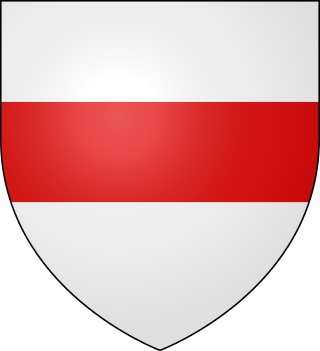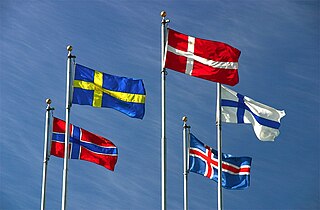Looser definition
As with the Canadian pale, a looser definition of Spanish fess also exists, in which the central stripe is considerably larger than, but not necessarily twice the width of the two outer stripes.
Other flags featuring a Spanish fess include the national flags of Lebanon, Cambodia, Laos and Tajikistan, the restored flag of Libya, the flag of French Polynesia, the flag of Prussia, and the proposed national flag of Cyprus. Had the flag of Israel lacked the top and bottom white bands, it too would have featured a Spanish fess.
This is a list of lists of universities and colleges by country, sorted by continent and region. The lists represent educational institutions throughout the world which provide higher education in tertiary, quaternary, and post-secondary education.

The national flag of Lebanon is formed of two horizontal red stripes enveloping a horizontal white stripe. The white stripe is twice the height (width) of the red ones —a Spanish fess. The green cedar in the middle touches each of the red stripes and its width is one third of the width of the flag.

The national flag of Tajikistan was adopted in November 1992, replacing the flag of the Tajik Soviet Socialist Republic of 1953. The flag features Pan-Iranian colors in a horizontal tricolor of red, white and green, with a yellow crown surmounted by an arc of seven stars at the centre. It has a width ratio of 2:3:2. The tricolor preserves the choice of colors in the former Tajik Soviet flag, as well as the 1:2 proportions.

In heraldry, a fess or fesse is a charge on a coat of arms that takes the form of a band running horizontally across the centre of the shield. Writers disagree in how much of the shield's surface is to be covered by a fess or other ordinary, ranging from one-fifth to one-third. The Oxford Guide to Heraldry states that earlier writers including Leigh, Holme, and Guillim favour one-third, while later writers such as Edmondson favour one-fifth "on the grounds that a bend, pale, or chevron occupying one-third of the field makes the coat look clumsy and disagreeable." A fess is likely to be shown narrower if it is uncharged, that is, if it does not have other charges placed on it, and/or if it is to be shown with charges above and below it; and shown wider if charged. The fess or bar, termed fasce in French heraldry, should not be confused with fasces.

In heraldry and vexillology, a Canadian pale is a centre band of a vertical triband flag that covers half the length of a flag, rather than a third as in most triband designs. This allows more space to display a central image. The name was suggested by Sir Conrad Swan, Rouge Dragon Pursuivant, and first used by Queen Elizabeth II as Queen of Canada proclaiming the new Canadian flag on 28 January 1965.

The flag of the Tajik Soviet Socialist Republic was the red Soviet flag with white and green stripes below the gold hammer and sickle, with the measures: 1/2 red, 1/5 white, 1/10 green, 1/5 red. The flag sported the Pan-Iranian colors of red, white and green, as a nod to the republic's Persian-descended culture. The flag was adopted on March 20, 1953 by decree of the Supreme Soviet of the Tajik SSR:
The national flag of the Tajik Soviet Socialist Republic is a panel consisting of four horizontal colored stripes: the upper band of red which is half the width of the flag; white stripe, making one fifth of the width of the flag; green stripes, is one-tenth the width of the flag, and the lower band of red color, is one-fifth the width of the flag. On top of the red band at the flagpole located gold hammer and sickle and above them is a five-pointed red star framed by a gold border. The ratio of the flag's width to its length is 1: 2.The fitting of the hammer and sickle into a square whose side wound 1/4 width of the flag. The sharp end of the sickle falls in the middle of the upper side of the square, handles the sickle and hammer rest on the bottom corners of the square. hammer with a handle length is 3/4 of the diagonal of a square. The five-pointed star in a circle fits 1/8 width of the flag relating to the upper side of the square. Distance vertical axis of the star, the hammer and sickle from the grapnel is equal to 1/4 of the flag's width. The distance from the top edge of the flag of the flag to the center of the star - 1/10 of the flag's width.
A triband is a vexillological style which consists of three stripes arranged to form a flag. These stripes may be two or three colours, and may be charged with an emblem in the middle stripe. All tricolour flags are tribands, but not all tribands are tricolour flags, which requires three unique colours.

Some of the colonies, protectorates and mandates of the French Colonial Empire used distinctive colonial flags. These most commonly had a French Tricolour in the canton.
This is a list of articles holding galleries of maps of present-day countries and dependencies. The list includes all countries listed in the List of countries, the French overseas departments, the Spanish and Portuguese overseas regions and inhabited overseas dependencies.

Military aircraft insignia are insignia applied to military aircraft to identify the nation or branch of military service to which the aircraft belong. Many insignia are in the form of a circular roundel or modified roundel; other shapes such as stars, crosses, squares, or triangles are also used. Insignia are often displayed on the sides of the fuselage, the upper and lower surfaces of the wings, as well as on the fin or rudder of an aircraft, although considerable variation can be found amongst different air arms and within specific air arms over time.
National records in athletics are the marks achieved by a nation's best athlete or athletes in a particular athletics event. These records are ratified by the respective national athletics governing body. A national record may also be the respective continental record (also called "area record", or even the world record in that event.

The flag of Mari El, a federal subject and republic in the Russian Federation, was adopted by the Parliament of Mari El on 1 June 2011.
The International Council of Museums defines a museum as "a not-for-profit, permanent institution in the service of society that researches, collects, conserves, interprets and exhibits tangible and intangible heritage. Open to the public, accessible and inclusive, museums foster diversity and sustainability. They operate and communicate ethically, professionally and with the participation of communities, offering varied experiences for education, enjoyment, reflection and knowledge sharing.”

Flag families are sets of national flags with similarities in their design, often based on a shared history, culture, or influence. Families do not include flags with coincidental similarities. Flags may be in multiple flag families. Only twelve current national flags existed before the 19th century, when large-scale flag use began. Seven of these flags are the inspiration for more than 130 current national flags and ensigns.
This page is based on this
Wikipedia article Text is available under the
CC BY-SA 4.0 license; additional terms may apply.
Images, videos and audio are available under their respective licenses.

































